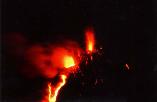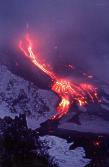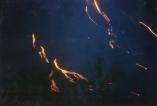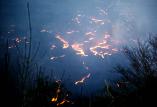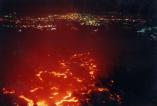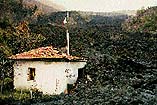| Etna
index |
||
| Geology | Geological history | Cones and craters |
| Eruptive characteristics | Eruptions before 1971 | Eruptions since 1971 |
| Etna and Man | References | Web sites |
| Weather forecasts | FAQ | Latest news |
The 1991-1993 Valle del Bove eruption
Etna produced its
most voluminous and longest-lasting flank eruption since about 300 years
between 14 December 1991 and 30 March 1993. Much of the southern part
of Valle del Bove was filled with a thick compound lava field, with maximum
thicknesses exceeding 100 m. About 205-250 m3 of lava were produced during
the 473 days of the eruption at an average rate of 5-6 m3 per second.
The eruption, though not particularly vigorous in terms of explosivity
and eruptive rates, became the most publicized eruptive event at Etna
so far, mostly due to the (at least partially) successful diversion of
lava flows that threatened the town of Zafferana Etnea. The lessons from
the 1991-1993 eruption should, however, not imply that man is now capable
of controlling the volcano. Several favorable factors allowed the relatively
successful lava diversion:
1) the low effusion rate. At a higher effusion rate, lava may have been
delivered through more than one main lava tube or flow channel, which
would have rendered any effort of diverting the lava more difficult. In
other flank eruptions with high effusion rates, such as that of 1981
on the NNW flank, broad, voluminous lava flows advanced very rapidly towards
towns and agricultural areas, without forming significant flow channels
or tubes, and therefore no diversion would have been possible.
2) the high elevation of the eruptive vents. The eruptive fissure lay
between 2350 and 2200 m altitude and therefore far away from inhabited
areas. The lava flow had to travel about 8 km before it became a serious
threat, and it took about 4 months to cover this distance. In the 1981
eruption, the lowest eruptive vents lay at 1150 m elevation, and the main
lava flow covered a distance of almost 8 km in little more than 40 hours.
3) the drop in the effusion rate shortly after the final blasting operation.
After that operation, carried out on 27 May 1992, lava did not travel
much farther than 3 km from the diversion site. Had the effusion rate
remained constant, then it would have been easy for the lava to build
another lava tube system similar to that formed in the first months of
the eruption, and this could have led to another advance of the lava fronts
to the area of Zafferana.
4) the possibility to divert the lava far away from the threatened areas.
The diversion was carried out at little below 2000 m elevation, and about
7 km from the nearest village. It did thus not result in a new threat
to another area, because all the diverted lava could accumulate in an
uninhabited area, far away from cultivated or inhabited land.
Map of the 1991-1993 lava flow-field
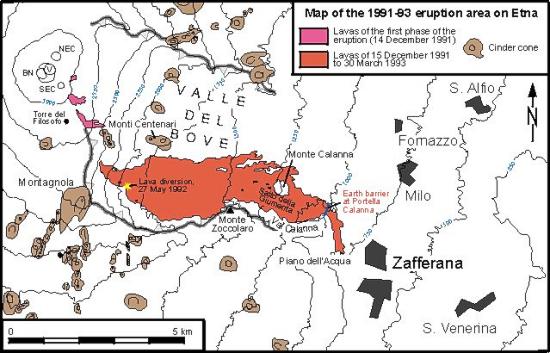
Map
of the eastern flank of Etna, showing the lava flow-field of the 1991-1993
eruption in the southern part of the Valle del Bove, and key locations
related to events during the eruption. The lavas erupted during the first
phase of the eruption (14 December 1991) are shown in different color
than the main lava flow. After the final diversion of the lava flow on
27 May 1992 (the site of this operation is indicated by a yellow asterisk),
lava continued to accumulate only in the upper third of the lava flow-field,
in the area where it is largest
 |
Lava
flows burying fruit gardens above the Piano dell'Acqua,
9 May 1992. This spring is the last for many of the trees visible
in these photos
|
 |
Continue
with
THE 1995-2001 SUMMIT
ERUPTIONS
Copyright © Boris Behncke, "Italy's Volcanoes: The Cradle of Volcanology"

